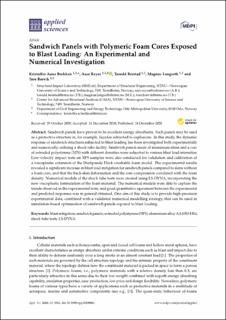| dc.contributor.author | Brekken, Kristoffer Aune | |
| dc.contributor.author | Reyes, Aase Gavina Roberg | |
| dc.contributor.author | Berstad, Torodd | |
| dc.contributor.author | Langseth, Magnus | |
| dc.contributor.author | Børvik, Tore | |
| dc.date.accessioned | 2021-01-25T13:11:08Z | |
| dc.date.accessioned | 2021-03-02T12:57:13Z | |
| dc.date.available | 2021-01-25T13:11:08Z | |
| dc.date.available | 2021-03-02T12:57:13Z | |
| dc.date.issued | 2020-12-18 | |
| dc.identifier.citation | Brekken, Reyes, Berstad, Langseth, Børvik. Sandwich panels with polymeric foam cores exposed to blast loading: An experimental and numerical investigation. Applied Sciences. 2020;10(24):1-36 | en |
| dc.identifier.issn | 2076-3417 | |
| dc.identifier.uri | https://hdl.handle.net/10642/9809 | |
| dc.description.abstract | Sandwich panels have proven to be excellent energy absorbents. Such panels may be used as a protective structure in, for example, façades subjected to explosions. In this study, the dynamic response of sandwich structures subjected to blast loading has been investigated both experimentally and numerically, utilizing a shock tube facility. Sandwich panels made of aluminium skins and a core of extruded polystyrene (XPS) with different densities were subjected to various blast load intensities. Low-velocity impact tests on XPS samples were also conducted for validation and calibration of a viscoplastic extension of the Deshpande-Fleck crushable foam model. The experimental results revealed a significant increase in blast load mitigation for sandwich panels compared to skins without a foam core, and that the back-skin deformation and the core compression correlated with the foam density. Numerical models of the shock tube tests were created using LS-DYNA, incorporating the new viscoplastic formulation of the foam material. The numerical models were able to capture the trends observed in the experimental tests, and good quantitative agreement between the experimental and predicted responses was in general obtained. One aim of this study is to provide high-precision experimental data, combined with a validated numerical modelling strategy, that can be used in simulation-based optimisation of sandwich panels exposed to blast loading. | en |
| dc.description.sponsorship | The present work has been carried out with financial support from the Centre of Advanced Structural Analysis (CASA), Centre for Research-based Innovation, at the Norwegian University of Science and Technology (NTNU) and the Research Council of Norway through project no. 237885 (CASA). | en |
| dc.language.iso | en | en |
| dc.publisher | MDPI | en |
| dc.relation.ispartofseries | Applied Sciences;Volume 10, Issue 24 | |
| dc.relation.uri | https://www.mdpi.com/2076-3417/10/24/9061 | |
| dc.rights | Creative Commons Attribution (CC BY) license | en |
| dc.rights.uri | https://creativecommons.org/licenses/by/4.0/ | |
| dc.subject | Blast mitigation | en |
| dc.subject | Sandwich panels | en |
| dc.subject | Extruded polystyrene | en |
| dc.subject | Aluminium alloys | en |
| dc.subject | Shock tube tests | en |
| dc.subject | LS-DYNA | en |
| dc.title | Sandwich panels with polymeric foam cores exposed to blast loading: An experimental and numerical investigation | en |
| dc.type | Journal article | en |
| dc.type | Peer reviewed | en |
| dc.date.updated | 2021-01-25T13:11:07Z | |
| dc.description.version | publishedVersion | en |
| dc.identifier.doi | https://doi.org/10.3390/app10249061 | |
| dc.identifier.cristin | 1862176 | |
| dc.source.journal | Applied Sciences | |
| dc.subject.nsi | VDP::Teknologi: 500 | |
| dc.subject.nsi | VDP::Technology: 500 | |
| dc.relation.projectID | Norges forskningsråd: 237885 | |

